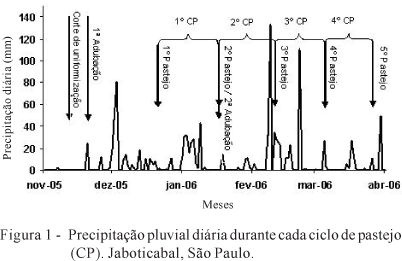It was evaluated morphogenetic and structural characteristics of the canopy of Brachiaria brizantha cv. Marandu under continuous grazing during the wet season, in different forage supplies and grazing cycles. A random block experimental design was used in a split-plot scheme with three replicates. It was evaluated in the plots the plots, the effects of forage supplies (4,7, 10 and 13% BW/day) and in the subplots, the effects of grazing cycles were evaluated. All the variables differed among grazing cycles, proving the great influence of environmental conditions on the evaluated characteristics. Stem elongation rate and canopy height showed linear and positive responses to the increase on forage supply. Number of vegetative tillers in the plots with the lowest supply was constant over the whole experimental period, however, in the plots with the other supplies, tillers reached highest values in the intermediate cycles. Density of total and reproductive tillers was fitted to the quadratic model accordingly to the forage supply. Pastures managed with forage supplies close to 4% BW/day showed lower stem elongation and they tend to reduce loses caused by senescence. Environmental variables affect morphogenetic and structural characteristics more than management with forage supply does.
Brachiaria brizantha; canopy height; grazing cycles; grazing intensity; morphogenesis; stem elongation





